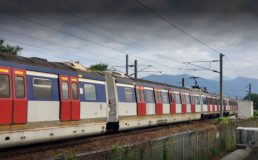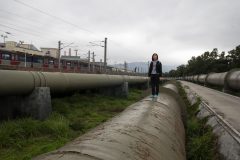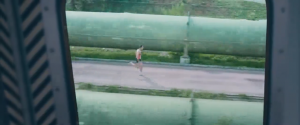ZERO TO HERO, DIR. Jimmy Wan (2021)
Big Water Pipes, Sheung Shui District, Hong Kong

Su competes with the train and successfully run faster than it. Su’s mother witnessed this exciting moment. Scenes from the Zero To Hero, 2021, directed by Jimmy Wan.
Zero to Hero 媽媽的神奇小子 (2021) directed by Jimmy Wan is a film adapted from a moving story of a Hong Kong Paralympic track and field gold medalist Su Huawei’s mother-child relationship and his struggle narratives with his mother “Su Ma” 蘇媽. In this film, there is a clip of disabled athlete Su competing with a train to run faster during his daily training and finally succeeds. The place filmed for this clip is along the Sheung Yue River, in Sheung Shui, where the Big Water Pipes大水管 lie. These pipes are the constructions that serve for transferring water sources from the Dongjiang River 東江, Guangdong Province to Hong Kong.
In the film, the river is not shown in the footage; instead, the clip shows the long railway and pipes. The extended pipes going forward in the distance imply the long and hard way of Su’s athletic career. The big pipe with ladder also provides a grandstand where Su’s mother stands and witnesses Su’s successful “defeat” the train. They also chat with each other on the ladder, where the mother encourages Su and enhances their relationship. Compared to reality, the train color is changed from red to grey and yellow in the film, which fits more with the green pipes as a whole scene. The display of this place combines the front horizontal aspect and an aerial perspective. It applies the interior approach to visualize the daily training route of Su.

Su and his mother chat on the ladder on the Big Water Pipes, Sheung Shui, Hong Kong. Scenes from the Zero To Hero, 2021, directed by Jimmy Wan.
In the reality, the Big Water Pipes is a famous tourist, where people go sightseeing of red train passing by and walking along the human-height pipes. Due to the COVID situation, I do the field trip virtually by searching the photos and experiences of other visitors. The photos of the landscape along the Sheung Yue River bring a feeling of peacefulness and harmonious relationship between pipes and grass, humans and nature. Most of the Hong Kong people are raised by the water transferred by these pipes from the Dongjiang River. Hence, this place implies the mother-kid relationship between the mainland and Hong Kong.
In my opinion, this place is filmed as the location where Su does his daily competition with train for two reasons. Firstly, the ladder on the pipes provides a stand for Su’s mother to interact and encourage Su in his training. Second, long-extended pipes in parallel with the railway create a feeling of endless running; the pipes add more context into the scene instead of just showing the audience Su and the train. The aerial perspective is used to perfectly show how Su runs faster than the train from a bird’s view, while the close shoot in the front displays the strong will and the self-confidence of Su in running. A perspective from the inner train is also used to give a 360 degree of the process of Su’s running.
— Ju Ran 3035844637


- Photos from the Internet show the view of the train and the Big Water Pipes in reality. Left: the red train goes parallel to the Dongjiang River and the pipes; picture from the google map. Right: the human-height pipes transfer water from the mainland, China to Hong Kong; picture from the link in reference.

View from the inner of the train when Su is running. Scenes from the Zero To Hero, 2021, directed by Jimmy Wan.
Reference:
大水管: 香港旅俠 – 香港青年協會青年領袖發展中心. 大水管 | 香港旅俠 – 香港青年協會青年領袖發展中心. (n.d.). Retrieved May 13, 2022, from http://l21.hkfyg.org.hk/bphk/index.php/2016/02/15/dashuiguan/
Google. (n.d.). Google maps. Retrieved May 13, 2022, from https://www.google.com.hk/maps/place/%E5%A4%A7%E6%B0%B4%E7%AE%A1/@22.5156402,114.1161188,3a,75y,90t/data=!3m8!1e2!3m6!1sAF1QipMXWOpcqxTXOWoL9v5kk_Zujv0iLDYQKEAZuf4Z!2e10!3e12!6shttps:%2F%2Flh5.googleusercontent.com%2Fp%2FAF1QipMXWOpcqxTXOWoL9v5kk_Zujv0iLDYQKEAZuf4Z%3Dw203-h152-k-no!7i4032!8i3024!4m9!1m2!2m1!1sBig+Water+Pipes!3m5!1s0x3403f675b61042cb:0x4e36b99fd8319e67!8m2!3d22.5156402!4d114.1161188!15sCg9CaWcgV2F0ZXIgUGlwZXNaESIPYmlnIHdhdGVyIHBpcGVzkgEVd2F0ZXJfdHJlYXRtZW50X3BsYW50mgEjQ2haRFNVaE5NRzluUzBWSlEwRm5TVU5uWnkxRFEwUkJFQUU
Appreciate your reflection on the pipe as a platform for viewing and cheering, and your observation of the long pipe that visually emphasizes the linearity and endless running. Beyond the point that all Hong Kongers are raised on Dongjiang River water, what other perspectives do you get from your virtual fieldwork research? It will be important to get more perspectives from more sources to better understand how Hong Kongers and tourists respond to and interact with the train and the pipes. References for your virtual fieldwork are a little limited. Cite your sources fully, including the reference from Google Maps.
Thanks for your feedback! I have updated my reference including the picture source from google Maps. And I will try to research more about the different perspectives of this place.